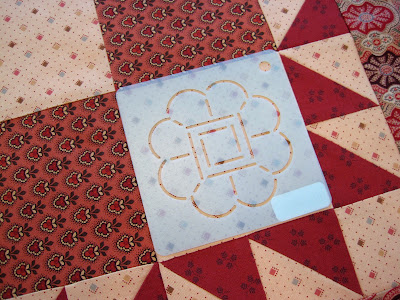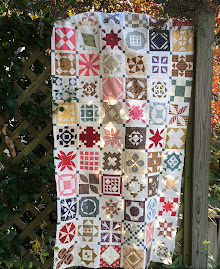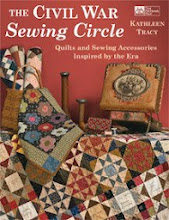Quilting can be such an individual "sport." It's difficult to give recommendations when what I suggest may not be close to being right for you. You have to experiment with the tools available and find what works best.
But, since you asked: While there are probably many good quilting threads out there that will suit you just fine, my all-time favorite hand quilting thread is the YLI brand. It's a 100% cotton thread with a glazed finish. I'm partial to the light brown as it goes well with light and dark fabrics and gives a nice primitive touch to my small quilts. I have several colors and interchange them depending upon the quilt.
Needles: I wish I could be more specific but I am sorry to tell you that there is no CORRECT needle to use for hand quilting. Because everyone is different, what is comfortable for me to use may not be right for you. The needle you use makes a huge difference. It should be one you can handle and thread easily or your quilting adventures will be disappointing and frustrating. You will need to select the needle you feel most comfortable using and should try several to see which one fits YOU. Don't give up on quilting until you try several different needle sizes and brands. I often use a different needle depending upon the fabric used in the project I am quilting or how my hands are feeling that day.
Many quilters use a traditional "Between" needle which is short, sturdy and thicker than most hand sewing needles. This is the needle most often recommended when you are just beginning to quilt. But, understand that not every needle is the perfect fit for every quilter, particularly when you are just starting out. With needles, the larger the number, the smaller the needle size. If you look at some you will see that the larger numbered needles are smaller and finer. My advice is - Don't start out with a size 12 quilting needle or you may become discouraged. They're very small and, for me, sometimes difficult to handle and control since my fingers are rather clumsy. When I first began to quilt, I assumed it was a RULE that you had to use a small Between. While many experienced hand quilters may like them, they may not be your best choice until you gain some proficiency. If you decide to try this type of needle for your hand quilting, buy a slightly larger needle at first (smaller number, larger needle, remember?) and work your way up. Even now, I like the control that a longer needle gives me. It just feels better in my hand.
Over the years, I've tried several different needles. I found that while Betweens may work for some, when I quilted with a small Between my hand would hurt because the needle was too thick and I had a difficult time pushing it through the layers. My quilting reflected that struggle. The smaller Betweens were finer but I still had trouble handling them because they were TOO small for me. My preference now is to use a Milliner's needle (or Straw needle), which is long and thin and allows me to sew through the layers more easily than those thick Between needles. Beginners may find that they are much easier to handle and that some brands will slide through the fabric with ease. I've also discovered that a "Sharp" needle glides through the quilt better than a Between and eases the stress on my hand.
Bottom line: My quilting improved when I began to use a longer, thinner needle instead of the tiny needle other quilters told me I should be using. I found I could also load more stitches on the needle and my hand did not tire as rapidly. Know what? The Quilt Police won't even know what needle you're using. Do what makes quilting enjoyable for you.
Bottom line: My quilting improved when I began to use a longer, thinner needle instead of the tiny needle other quilters told me I should be using. I found I could also load more stitches on the needle and my hand did not tire as rapidly. Know what? The Quilt Police won't even know what needle you're using. Do what makes quilting enjoyable for you.
You can see I don't do much fancy stitching. Lots of straight lines.
Try several different needles and sizes until you find the one that is most comfortable to use. Focus on being able to quilt a straight line at first. When your stitches become smaller with practice and you gain proficiency you can always switch to a smaller needle and do fancier quilting. Some companies sell needle assortments so you can try several different-sized needles in one package and see which one you like best.
Here are a few good quality needles to try -
Foxglove Cottage - I use Jeana Kimball's size 8 Milliner's or Straw needles for hand quilting. These are my favorite needles. Long and thin but strong.
John James Gold'n Glide needles - I like these for applique. Have also used their Milliner's and Sharps. Their quilting needles have been recommended to me. Have not tried them yet but plan to try the size 9 (although, these still look pretty small)
Richard Hemming needles - I have tried the size 10 Milliner's needles for quilting. They also make large eye quilting needles.
Clover Black Gold needles - I've heard these are good. Haven't tried them.
Tulip Hiroshima needles - I've heard very good things about these too and mean to pick up some soon. A little more pricey than the others.
Batting is important as well. Again, everyone who quilts has a favorite batting and the one I use may not be one you will like. For what it's worth, my favorite is the Fairfield brand 100% natural cotton batting made by the Polyfil Company. Low loft, very thin, easy to quilt through. Let me repeat that - a thin batting is easier to quilt through. It also gives your small quilts that antique look. Shrinks a little when washed so your quilt will pucker slightly after it dries. Keep in mind that heavier battings like Warm & Natural are great for large machine-quilted quilts but can make hand quilting your small quilt extremely difficult. Why not make it as easy as possible? I've heard that some quilters use flannel but I have never tried it on my small quilts. I like a batting that gives a little body to my project and I'm not sure flannel will do that. But I may still try it one day. Polyester batting will make your quilt look too puffy so avoid those. Some swear by wool. I found what I like and I stick with it. Cotton works for me. Try some different kinds.
You asked: No, I do not use a hoop. I tried it and now just prefer to quilt on my lap. Usually with my feet up. I place my pin-basted, marked project on top of a cushioned lap desk (see photo below). The lap desk sits on top of a small pillow which is then placed upon my lap. The top of the lap desk is flat and supports my hands and wrists when I sew. As unconventional as it sounds, it's a perfect solution for me and reduces any neck or shoulder stress. The pillow raises my quilt to a comfortable level where I can see what I'm stitching without contorting my neck or getting eyestrain because it's too far away. I can also lean back on a sofa pillow, tilt the desk and lift up my knees on the couch to support the pillow underneath if I feel like it. My back and shoulders are more relaxed when I'm not hunched over. Way too much information?? What can I say - I like to get comfy cozy when I quilt.
I know that there is a lot to learn - you have to be patient. Perfection does not come the first time you quilt. Also, keep in mind I am not an expert. I just know what works for me to help me do the kind of quilting I choose to do right now, which is simple, enjoyable stuff. Who knows - I may aspire to become a much better quilter and quilt feathers someday when I retire and have more time. That's not feasible for me right now.
There are many resources for all of this on the internet so do some research. YouTube has numerous hand quilting videos and Craftsy even has an online class or two. Think about my suggestions or ask around at your local shop or guild. And then, go ahead, mark your quilt and get started! Hand quilting is fun. But you won't really know until you try.
There are many resources for all of this on the internet so do some research. YouTube has numerous hand quilting videos and Craftsy even has an online class or two. Think about my suggestions or ask around at your local shop or guild. And then, go ahead, mark your quilt and get started! Hand quilting is fun. But you won't really know until you try.









































































